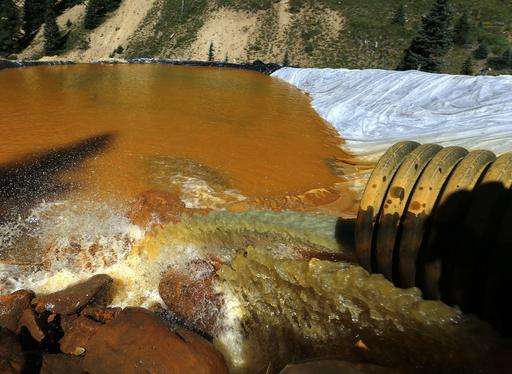Storms raised some pollutants after mine spill, not others

Runoff from autumn storms kicked up the levels of some contaminants in a southwestern Colorado river after a massive spill of toxic mine waste, but concentrations of other pollutants declined or didn't change, researchers said Friday.
A report released by the Environmental Protection Agency could offer clues about what will happen to the Animas River this spring and summer when melting snow from the San Juan Mountains makes the waterway run higher, potentially stirring up pollutants that had settled to the bottom after the spill.
But the researchers said they couldn't be sure that the pollutants they measured came from the Gold King Mine—source of the 3-million-gallon spill last August—or if they were from other mines that riddle the area. They also said they didn't have enough historical data to know whether storms that hit after the Gold King spill stirred up more pollutants than ones before it.
The EPA inadvertently triggered the Gold King spill while performing preliminary cleanup work. The spill dumped an estimated 880,000 pounds of heavy metals including arsenic, copper, lead, mercury and aluminum into rivers in Colorado, New Mexico and Utah.
Most of the metals settled to the bottom of the Animas before reaching the San Juan River in New Mexico, the EPA said. Experts have differed on whether and how much those metals will be stirred up when river flows increase after storms and from the spring snowmelt.
The nonprofit Mountain Studies Institute in Silverton monitored the river for the EPA in Durango, Colorado, about 60 miles downstream from the mine, and compiled a report.
Seven storms increased the flow of the Animas in Durango between Aug. 9 and Oct. 26. Concentrations of six contaminants increased after some of those storms, including aluminum and copper, the institute's report said.
Levels of mercury and five other contaminants decreased after some storms, while the levels of seven others didn't change.
State water officials don't expect floods or above-normal flows in the Animas this spring and summer. The San Juan Mountain snowpack that melts into the river was only 66 percent of the long-term average on Friday.
Even if a weekend storm drops up to 2 feet of snow on the San Juans as predicted, it probably won't be enough to cause the Animas to flood, said Kevin Houck, chief of watershed and flood protection for the Colorado Water Conservation Board.
More information: Mountain Studies Institute Report: tinyurl.com/h5xhamm
© 2016 The Associated Press. All rights reserved.


















